#Lord Shrinathji Pichwai
Photo
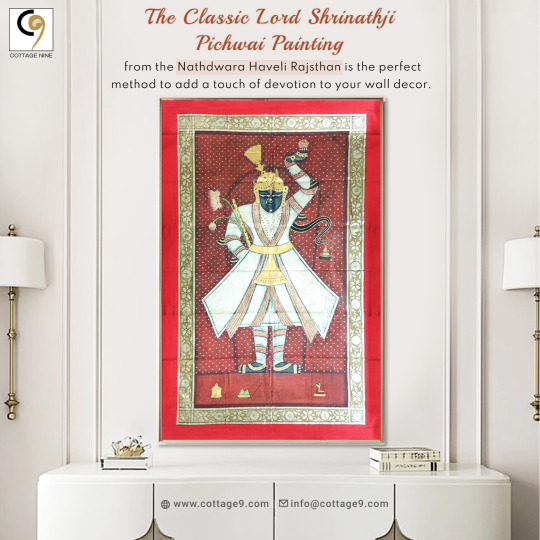
The classic Lord Shrinathji Pichwai painting from Nathdwara Haveli Rajasthan is the perfect way to enhance your wall decor with a touch of devotion.
0 notes
Text
The Timeless Charm of Nathdwara: Exploring Beyond the Temple
Introduction:
In the heart of Rajasthan, in the picturesque town of Nathdwara, there are strong spiritual ties that are primarily focused on the revered Shrinathji Temple. However, Nathdwara has a timeless allure that attracts tourists regardless of its spiritual value. In addition to the unrivaled comfort of Vaikunth by Adamo Hotels, which is close to the well-known Shrinathji Temple, we welcome you to explore the hidden treasures of Nathdwara in this blog.

1. The Enchanting Streets of Nathdwara: If you leave the temple, you'll live in a whole different universe. Nathdwara's streets have an old-world beauty due to its winding walkways and crumbling architecture. Seeing havelis with exquisite carvings and other buildings with Rajput and Mewari architectural influences is beautiful. As you walk through these hallways, the history that surrounds you will transport you back in time.
2. A Glimpse into Rajasthani Culture: Nathdwara is a cultural center in addition to being a spiritual center. Don't miss the chance to see the beautiful bhajans (devotional songs) and mesmerizing folk dances performed by local musicians. Through these cultural exhibits, where tradition and devotion join together, visitors can gain a sense of the essence of Nathdwara.
3. Savoring Local Delicacies: Learning about a place's culture through its food can be a terrific way to do so, and Nathdwara does not disappoint. Test out the hearty Dal Baati Churma and delectable Gatte ki Sabzi, two traditional Rajasthani dishes. A delectable dessert that will satisfy your appetite is the famed "Peda," which you should also try.
4. Artistry and Craftsmanship: The beautiful textiles, jewelry, and idols produced by Nathdwara's artists and crafters are well known. Peek into their world and see the exquisite artistry that has been handed down over the decades. The best part is that you can bring a priceless piece of Nathdwara art back with you.
5. Experiencing the Divine: The Shrinathji Temple, which acts as the town of Nathdwara's spiritual core, is surrounded by a large number of other temples and holy places. Knowing the individual significance and history of each person can help one feel more spiritually connected.
6. Pilgrimage to Shrinathji Temple: Devotees of Lord Krishna reverently travel to the Shrinathji Temple in Nathdwara, Rajasthan, for religious purposes. Shrinathji, the god and a young version of Lord Krishna resides at this famous temple, which is renowned for its spiritual significance, aesthetic beauty, and daily rituals.
7. Festivals and Celebrations: Nathdwara comes alive during festivals like Janmashtami and Holi. These celebrations are not just religious but also cultural extravaganzas, where the entire town participates in vibrant processions, traditional music, and dance performances. Attending these festivals is a unique opportunity to immerse yourself in the local traditions and revel in the joyous atmosphere.
8. The Art of Pichwai Paintings: The Shrinathji Temple in Nathdwara, for example, is decorated with pichwai paintings, a traditional form of art. These astonishingly lifelike, colorful, and rich paintings depict scenes from Lord Krishna's life. Visit adjacent studios to observe artists at work and perhaps purchase these wonderful works of art as gifts.
9. Eco-Tourism at Kankroli: The tranquil Rajsamand Lake is well-known in Kankroli, a city close to Nathdwara. At this ecological attraction surrounded by breathtaking nature, boat trips and bird watching are both available. It's the ideal location for nature enthusiasts and a welcome diversion from the seriousness of the temple.
10. The Warmth of the Locals: Nathdwara is not just about places and things; it's about people. The locals here are known for their warm hospitality and welcoming nature. Engage in conversations with them, and learn about their traditions, and you'll find that the people of Nathdwara are an integral part of the town's timeless charm.
Conclusion:
The city of Nathdwara has a timeless allure that is simply waiting to be found, despite the fact that its well-known temple typically casts a shadow over it. As you meander around the town's lovely streets, allow the vibrant tapestry of its culture, history, and tradition to fascinate you. Nathdwara delivers a comprehensive experience that will have a significant impact on your soul beyond just religious piety. Whatever you're seeking—spirituality, cultural enrichment, or just a taste of Rajasthan's inborn charm—Nathdwara has it and is just waiting to be discovered outside the temple gates.
6 notes
·
View notes
Text
Immerse Yourself in Indias Rich Heritage with Pichwai Wallpapers
Discover the Beauty of Pichwai Art
Imagine integrating the brilliant colors and rich elements of Indian culture into your house. Pichwai wallpapers provide a unique opportunity to accomplish precisely that. These intriguing wallpapers, inspired by the rich history of Pichwai paintings, bring life to your walls while adding a sense of cultural refinement.
What are Pichwai Paintings?
Pichwai (pronounced Pich-hwai) refers to religious cloth paintings originating in Rajasthan, India. These paintings traditionally served as backdrops for Shrinathji, a special form of Lord Krishna, portraying episodes from Krishna’s life in Vrindavan. Pichwai art is recognized for its breathtaking beauty, featuring natural dyes, exquisite gold leaf work, floral themes, and figurative iconography.

Pichwai Wallpapers: A Modern Transformation
The spirit of Pichwai art is now finding a new canvas: your walls. Pichwai wallpapers capture the beauty of these traditional wall murals in a modern style, making them more accessible to a wider audience.
Why Choose Pichwai Wallpapers?
Uniqueness: Pichwai wallpapers add creativity and cultural richness to your home decor. With intricate motifs and brilliant colors, they effortlessly boost the ambiance of any room, creating a unique and unforgettable space.
Cultural Connection: Decorating with Pichwai wallpapers pays homage to India’s rich artistic legacy. It infuses your living space with a feeling of history, authenticity, and respect for artistic mastery.
Adaptability: Pichwai wallpapers come in a vast choice of colors, patterns, and themes. Whether you want a quiet ambiance in a puja room or vibrancy in a busy living space, Pichwai designs suit any aesthetic vision.
Experience the Magic of Pichwai Wallpapers
Explore Magicdecor beautiful collection of Pichwai wallpapers. With high-quality materials and customizable options, they can transform your space into a one-of-a-kind and inspiring retreat.
#pichwai painting#home & lifestyle#positivity#art#indian tradition#design#Kamdhenu Sacred Cow Pichwai
1 note
·
View note
Text
Udaipur to Shrinathji Temple: A Journey Through Rajasthan’s Spiritual Heart
The journey from Udaipur to Shrinathji Temple is more than a mere physical transition between two locations; it is a voyage into the spiritual and cultural heart of Rajasthan. This route, steeped in historical and religious significance, offers travelers a unique blend of scenic beauty, cultural richness, and profound spirituality. For those seeking a convenient and comfortable travel experience, Shree Laxmi Taxi provides an exceptional service, ensuring that your pilgrimage is as memorable as the destination itself.
The Sacred Destination: Shrinathji Temple
Shrinathji Temple, located in Nathdwara, approximately 48 kilometers from Udaipur, is a major pilgrimage site for followers of the Vaishnavism tradition of Hinduism. The temple is dedicated to Lord Shrinathji, a manifestation of Lord Krishna, who is revered for his divine love and miraculous deeds. The deity of Shrinathji is depicted as a seven-year-old child, and the temple's rich history dates back to the 17th century, making it a cornerstone of Rajasthan's religious landscape.
The Route: Udaipur to Shrinathji Temple
Traveling from Udaipur to Shrinathji Temple is a relatively short journey that typically takes about an hour by car. The most popular route is via NH58, which is well-maintained and offers a smooth drive through picturesque landscapes. The route meanders through the Aravalli hills, dotted with small villages, lush green fields, and the occasional sighting of local wildlife, providing travelers with a serene and scenic backdrop.
Highlights Along the Way
Eklingji Temple: About 22 kilometers from Udaipur, this temple complex is dedicated to Lord Shiva and is a popular stop for pilgrims and tourists alike. Its intricate architecture and historical significance make it a must-visit.
Haldighati: This historical site, around 40 kilometers from Udaipur, is famous for the Battle of Haldighati fought between Maharana Pratap and the Mughal forces. The Haldighati Museum offers a glimpse into the valor and history of Rajasthan’s warrior heritage.
Nathdwara Town: Before reaching the temple, the town of Nathdwara itself is worth exploring. Known for its pichwai paintings and vibrant markets, it provides a delightful experience of local culture and craftsmanship.
The Spiritual Experience
Upon reaching Shrinathji Temple, pilgrims are welcomed by an atmosphere of devotion and tranquility. The temple’s architecture is a splendid example of medieval Indian craftsmanship, with its ornate marble carvings and beautiful wall paintings depicting scenes from Lord Krishna's life. The main deity, Shrinathji, is adorned with opulent jewelry and colorful garments, which are changed several times a day in a ritual known as "Shringar."
Daily Rituals and Festivals
The temple’s daily schedule includes several darshans (viewings of the deity) that attract thousands of devotees. Each darshan has its own unique significance and is accompanied by melodious bhajans (devotional songs). Major festivals like Janmashtami, Diwali, and Holi are celebrated with great fervor, drawing even larger crowds and enhancing the spiritual experience with elaborate rituals and festivities.
Shree Laxmi Taxi: Your Trusted Travel Partner
When embarking on the journey from Udaipur to Shrinathji Temple, Shree Laxmi Taxi stands out as a reliable and comfortable travel option. Here’s why:
Comfort and Convenience
Shree Laxmi Taxi offers a fleet of well-maintained vehicles ranging from sedans to SUVs, ensuring a comfortable ride for individuals, families, and larger groups. The taxis are equipped with modern amenities, providing a relaxing travel experience.
Experienced Drivers
The drivers at Shree Laxmi Taxi are not only skilled and professional but also knowledgeable about the local routes and cultural significance of the places along the way. Their insights and courteous service enhance the overall travel experience.
Customizable Packages
Shree Laxmi Taxi offers customizable travel packages that cater to your specific needs. Whether you want to make stops at various attractions along the route or require a round-trip service, the company provides flexible options to suit your itinerary.
Safety and Reliability
Safety is a top priority for Shree Laxmi Taxi. The vehicles are regularly serviced and sanitized, and the drivers follow all safety protocols to ensure a secure journey for all passengers. The company’s commitment to punctuality and reliability ensures that you reach your destination on time, without any hassles.
Conclusion
The journey from Udaipur to Shrinathji Temple is a deeply enriching experience that combines the best of Rajasthan’s spiritual, cultural, and natural beauty. With Shree Laxmi Taxi, travelers can enjoy a seamless and enjoyable trip, focusing on the spiritual journey without worrying about the logistics. Whether you are a devotee on a pilgrimage or a tourist exploring the religious heritage of Rajasthan, this journey promises to be a memorable and inspiring adventure.
1 note
·
View note
Text
Discover the Divine Art of Shrinathji Pichwai Paintings
Explore Authentic Shrinathji Pichwai Artworks at Beyond Square
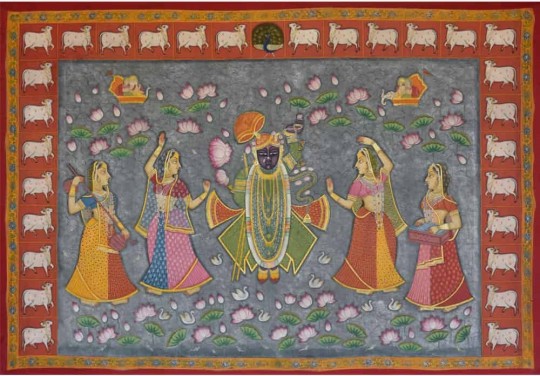
Shrinathji Pichwai paintings are revered works from Nathdwara, Rajasthan, depicting Shrinathji, an incarnation of Lord Krishna. These artworks are integral to the Pushtimarg sect's worship, showcasing scenes from Krishna’s life with vibrant colors and meticulous details. Beyond Square emerges as a premier online destination for these traditional paintings. Offering a range of authentic Shrinathji Pichwai, Beyond Square ensures quality and authenticity, connecting art lovers with genuine pieces directly from skilled artisans. Whether you're an art collector or a devotee, Beyond Square provides a trusted platform to own a piece of this sacred art.
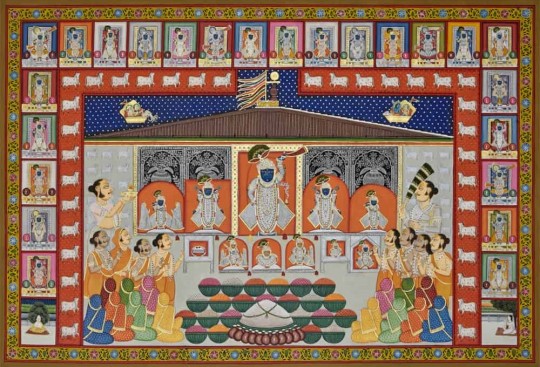



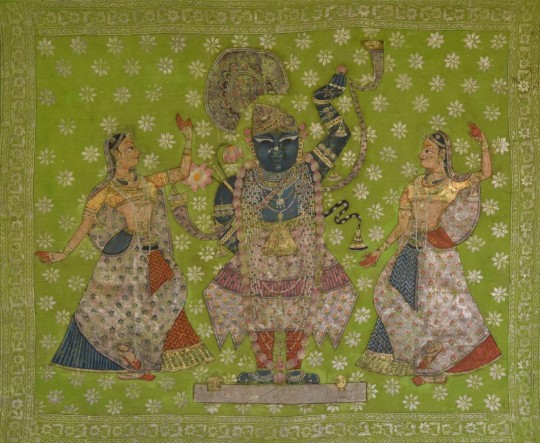
0 notes
Text
Pichwai Painting of Rajasthan: A Vibrant Art Form Celebrating Lord Krishna
Shrinathji Pichwais: These paintings depict the deity Shrinathji, a form of Lord Krishna that is worshipped in the Nathdwara temple. Shrinathji Pichwais are usually painted in a specific style, with the deity depicted as a young boy with a distinctive black complexion.
#Shreenathjipichwaispainting#Pichwaipaintingrajasthan#Pichwaiartofrajasthan#Pichwaipaintingdesigns#Pichwaipainting
0 notes
Text
Nazm Collection | Traditional Pichwai Art
Nazm is an assortment of classic angrakhas, tunics, kurtas and dresses that defy the vagaries of style. From hand-dyed Leheriya dupattas to intricate Nathdwara Pichhwai embroideries, each pays homage to Sunira’s dedication towards sustainability, Indian textiles and labour-intensive craft and handwork.
Nazm’s heavy threadwork and hand-embroidery is inspired by the traditional Pichwai paintings native to the temple town of Nathdwara in Udaipur, Rajasthan. Pichwai originated in the 17th century when artists, out of devotion, painted backdrops to hang behind the idol of Shrinathji and depict the “leelas” of Lord Krishna with the moon, lotus blooms, peacocks, parrots, and birds nestled in lush foliage creating the most scenic setting. Our Nazm collection is an ode to the labour of love and devotion and an effort to capture the intricacies, awe-inspiring combinations and the jeweled quality of traditional Pichwai.
0 notes
Video
youtube
Shrinathji Pichwai painting | Traditional Art and Painting | Lord Krishn...
1 note
·
View note
Text
10 Reasons Why People Celebrate Falgun in Shreenathji- Explore the Beauty of Nathdwara in Fagun Mas (Nathdwara)
Introduction
Nathdwara is a famous pilgrimage town in Rajasthan, India, known for its Shreenathji temple is a form of Lord Krishna, and the temple is considered one of the most sacred places for Vaishnavites.
Visitors come to Nathdwara to see the elaborate and ornate temple dedicated to Shreenathji, which features intricate carvings and paintings. The temple also has a unique system of worship and rituals, which attract devotees and tourists alike.
Apart from the temple, Nathdwara is known for its traditional Pichwai paintings, depicting scenes from Lord Krishna's life.
In the 45-day Falgun month, a wave of joy spread among the devotees, which the anthem of Rasiya, the tune of the Dap (this is the instrument which is used during Rasiya), and clouds of color powder (Abir and Gulal) are waiting for Falgun month.
What is Falgun month?
Falgun is the fifth month of the Hindu calendar and is considered an auspicious month in which many festivals are celebrated. In the Shreenathji Nathdwara tradition, In this month during which Holi, the festival of colors, is celebrated with great enthusiasm and devotion to Lord Krishna.
During this month, special rituals, prayers, and festivities are held at the Shreenathji temple in Nathdwara, Rajasthan, India. The idol of Lord Krishna is adorned with colorful clothes and flowers, and devotees offer special prayers and sing hymns in his honor.
In addition to Holi, other important festivals like Maha Shivaratri and Vasant Panchami may also be celebrated during the month of Falgun.
which falls between February and March in the Gregorian calendar, various instruments can be used during devotional singing, such as the mridangam, tabla, harmonium, and flute, and what is most special is the ‘Dhap’.Specific songs sung (Rasiya) during this time may vary depending on local customs and traditions.
Here are ten reasons why people celebrate Falgun in Nathdwara:
Nathdwara is a religious and spiritual place where Falgun month is very important. This month, we enjoy playing Gulal in 45 days and listening to Rasiya from Basant Panchami.
Which is a wonderful sight of friendship(सखा भाव) between Shreenathji and his devotees. The town also has several other temples and holy sites, including the Dwarkadheesh Temple, the Eklingji Temple, and the Charbhuja Temple.
1. Devotion to Shreenathji: Devotion to Shreenathji is a form of Bhakti yoga, a spiritual path in Hinduism that involves devotion and love towards a deity.
Shreenathji is a form of Lord Krishna worshiped mainly in the Pushti Marg tradition of Hinduism. Devotees of Shreenathji express their devotion through various means, including daily worship rituals, singing devotional songs, performing seva (service) in the temple, observing fasts, and celebrating festivals.
The essence of devotion to Shreenathji is to cultivate a deep love and attachment to the divine and to serve the Lord with devotion and selflessness.
2. Falgun Mela: Falgun Mela is a popular annual festival that takes place in Nathdwara, Rajasthan, India during the Hindu month of Falgun (February/March).
The festival is celebrated with great enthusiasm and is known for its colorful processions, cultural performances, and traditional food stalls. It is a significant event for the local community and attracts a large number of visitors from all over India.
3. Holi: Holi is celebrated with great enthusiasm at the Shrinathji Temple in Nathdwara, Rajasthan. The festival usually falls in the month of March and is celebrated with colorful and joyous festivities.
Devotees gather at the temple to offer prayers and participate in the traditional 'Holi Phagotsav' where they play with colored powders and sing devotional songs.
The atmosphere is filled with music, dance, and zeal, making it a unique and memorable experience for visitors. Falgun month is a month of playing with Shreenathji in a friendly manner(सखा भाव).
4. Special prayers and rituals: During this month, special prayers and rituals are performed at the Shreenathji Temple in Nathdwara to mark the occasion. The unique instrument used for music is called ‘Dhap’.
One of the major highlights of the Falgun month celebrations is the "Dolotsav" or "Holi Utsav," which is celebrated on the full moon day of the month.
During this celebration, the idol of Shreenathji is placed on a swing and devotees take turns swinging the deity, while singing hymns and offering flowers and sweets. The festival concludes with a grand procession, which is taken out from the temple and goes around the town of Nathdwara.
5. Singing and dancing: Yes, singing and dancing are an integral part of the Holi celebrations in the temple in Nathdwara. The devotees sing bhajans(Rasiya) and hymns in praise of Lord Krishna and dance to the beat of drums and cymbals.
During the "Dolotsav" or "Holi Utsav," as I mentioned earlier, the idol of Shreenathji is placed on a swing, and the devotees take turns swinging the deity while singing and dancing around the swing.
The atmosphere in the temple during this celebration is lively and colorful, with people throwing colored powder and water at each other.
In addition to this, the temple also hosts cultural programs during the Holi festival, where local artists and musicians perform traditional folk dances and songs. These programs
are a major attraction for tourists and visitors who come to Nathdwara to witness the grand celebrations of Holi in the temple.
( चंचल चपल चतुर चंद्रावली चाले चटक मटक की चाल… )
6. Cultural heritage: Nathdwara, located in the state of Rajasthan, India, has a rich cultural heritage that is deeply intertwined with its history, religion, and traditions. The town is primarily known for the temple, which is one of the most important pilgrimage sites for the followers of Lord Krishna.
Apart from the temple, Nathdwara is also known for its vibrant art and craft traditions, such as Pichwai paintings, which depict the life of Lord Krishna, and the famous Nathdwara-style miniature paintings.
The town is also famous for its marble sculptures and stone carvings, which are used to create idols and other decorative pieces.
Nathdwara is also known for its colorful festivals and fairs, such as the Falgun Mela and the
Janmashtami festival attracts a large number of visitors from all over the country.
The town is also home to several traditional folk music and dance forms, such as Ghoomar, Kalbelia, and Bhavai, which are performed during festivals and other cultural events.
7. The opportunity to seek blessings: Basant Panchami falls on Magh Shulka paksha Panchami, and from this day Rasiya singing starts in front of Shreenathji in the temple.
This month is a time when devotees come to Nathdwara to seek blessings and pay homage to Lord Krishna. Seeking blessings is a matter of personal belief and practice.
Shreenathji is a form of the Hindu deity Lord Krishna, worshipped primarily by the Pushtimarg sect. Devotees believe that seeking blessings can bring spiritual and material prosperity.
If you are interested in seeking blessings, you may want to learn more about the traditions and practices of the Pushtimarg sect, and consider visiting a temple or seeking guidance from a Pushtimarg guru as Goswamivishalnathdwara
8. The spirit of community: The temple is considered the spiritual hub of the Pushtimarg community and attracts devotees from all over the world.
In Nathdwara, you will find a vibrant spiritual community centered around the Temple, consisting of devotees, priests, and volunteers who are dedicated to the worship and service of Lord Krishna in the form of Shreenathji.
The community is known for its devotion, rituals, and customs, which are unique to the Pushtimarg tradition. Apart from the temple, Nathdwara also has several other important sites and landmarks associated with the Pushtimarg tradition, such as the Govardhan Nathji Temple, and the Rajsamand Lake.
These places also attract devotees and visitors who come to experience the spiritual atmosphere and seek blessings from Lord Krishna.
9. The beauty of the town: Nathdwara is a town located in the Aravalli hills of the Indian state of Rajasthan. The town is famous for its Shreenathji Temple, which is an important pilgrimage site for Hindus and attracts devotees from all over the world.
Besides its spiritual significance, Nathdwara is also known for its natural beauty and cultural heritage. The town is surrounded by picturesque hills and is located near the Banas River, which adds to its scenic charm.
Nathdwara has several historic landmarks and attractions, such as the Sita Mata Wildlife Sanctuary, the Haldighati Battlefield, and the Kumbhalgarh Fort, which are popular among tourists.
The town also has a vibrant bazaar where visitors can find traditional Rajasthani handicrafts, such as paintings, pottery, and textiles.
10. A time of joy: The one who sings Rasiya and all who hear it get drenched in pleasure. This month is a time of great joy and is celebrated by people of all ages and backgrounds. It is a time to forget all worries and come together to celebrate the arrival of spring and the beauty of life.
This is a month in the Hindu calendar that typically falls in February or March, and it is associated with the festival of Holi. Holi is a joyous celebration that is widely observed in Nathdwara and other Hindu temples.
During Holi, devotees gather at the temple to offer prayers, play with colored powders, and enjoy sweets and other festive foods. So, Falgun is considered a time of joy in Nathdwara due to the celebration of Holi.
Conclusion-
Falgun month is a very special, colorful, and friendly month for Shreenathji and his devotees, Basant Panchami, Ashtak, Holi, Dol are all included in this month between Gulal and Abir and all have their own importance. Nathdwara's cultural heritage is a rich tapestry of art, craft, music, dance, and festivals, which reflect the town's deep connection with its history, religion, and traditions.
Frequently Ask Questions
Q. 1- Is there any facility in the name of VIP in Nathdwara Temple?
Ans. Before coming to the Nathdwara temple, we should be aware that there is no such VIP facility in the name of Darshan in Nathdwara. Money should not be given in the name of VIP’s darshan.
Q. 2- What are the other places to visit in Nathdwara?
Ans. Nathdwara is a small town located in the state of Rajasthan, India. It is known for its famous Shrinathji Temple, which is a popular pilgrimage site for Hindus. Apart from the Shrinathji Temple, there are several other places to visit in Nathdwara. Here are some of the most notable ones:
Statue of Belief: there is a "Vishvas Savroopam" or "Statue of Belief" in Nathdwara. This refers to a statue of Lord Shiva that is located near the Shrinathji Temple. It stands at a height of 351 feet, making it one of the tallest statues in India. The statue is made of bronze and is located on a hill near Nathdwara town.
Charbhuja Temple: This temple is located about 30 km from Nathdwara and is dedicated to Lord Vishnu. It is an important pilgrimage site for Hindus, and the temple architecture is worth admiring.
Haldi Ghati: This historic site is located about 40 km from Nathdwara and is famous for the Battle of Haldi Ghati fought between Maharana Pratap and the Mughal Army. There is a museum here that showcases the history of the battle.
Eklingji Temple: This ancient temple is located about 22 km from Nathdwara and is dedicated to Lord Shiva. The temple has unique architecture and is an important pilgrimage site for Hindus.
Rajsamand Lake: This beautiful lake is located about 70 km from Nathdwara and is known for its serene surroundings. It was built in the 17th century and is a popular spot for picnics and boating.
Kankroli Temple: This temple is located about 15 km from Nathdwara and is dedicated to Lord Krishna. It is one of the largest temples in the region and is an important pilgrimage site for Hindus.
Mewar Haveli: This historic haveli is located in the heart of Nathdwara and is worth a visit for its architecture and history.
Nathdwara Market: The market in Nathdwara is a great place to buy souvenirs, traditional Rajasthani clothes, and handicrafts.
These are some of the most popular places to visit in Nathdwara, and each of them has something unique to offer to visitors.
0 notes
Text
Pichwai Paintings | Shreenath Ji, Krishna Pichwai Paintings Online
https://www.artflute.com/collections/pichwai-paintings
Pichwai paintings are a traditional form of Indian painting that dates back to the 18th century. The word "Pichwai" comes from the Hindi word meaning "cloth painting." Pichwai paintings are typically done on cloth, though they can also be done on paper or canvas.
Pichwai paintings typically depict Hindu deities, such as Krishna, Radha, and Shiva. They are often brightly colored and highly decorative. Pichwai paintings are usually made in a series, with each painting telling a story from Hindu mythology.
Pichwai paintings are not only beautiful works of art, but they also offer a glimpse into Hindu culture and religion. If you're interested in learning more about Hinduism, Pichwai paintings are a great place to start. Pichwai paintings often depict scenes from the popular Hindu epic, the Mahabharata. The Mahabharata is a long and complex story that tells the tales of two warring branches of a royal family. The story is full of gods and goddesses, heroes and villains, and can be difficult to follow. However, the Pichwai paintings of the Mahabharata provide a helpful visual guide to the story.
Here are some of the best Pichwai paintings -
The Pichwai painting that depicts the birth of Krishna is said to be one of the most beautiful and popular Pichwai paintings.
Another popular Pichwai painting is one that shows Krishna and Radha enjoying a dance together.
The Pichwai painting that depicts the death of Shiva is also a popular choice.
There are also many Pichwai paintings that depict scenes from the Mahabharata, such as the battle between the Pandavas and the Kauravas.
Finally, there are also many Pichwai paintings that depict Hindu deities in their natural environment, such as Krishna playing his flute in a forest.
Let’s see how Pichwai painting is made -
The first step in making a Pichwai painting is to choose the right cloth. The cloth must be of a high quality and should be a dark color. Once the cloth is chosen, it is then primed with a mixture of powdered resin and chalk.
After the cloth is primed, the outlines of the painting are drawn on it. Once the outlines are complete, the painting is filled in with colors. Finally, the painting is varnished to protect it.
The preparation of a Pichwai painting for the temple backdrop can take a few weeks to several months. Wealthy families commission artwork for the temple, but there are also smaller replicas available for the average person to keep at home in their own shrines. Since it is forbidden to take photos inside the temple, Pichwai painters also create paintings of Shrinathji's idol in the same manner. This helps them with business and satisfies devotees who want to take an image of their lord with them.
The paintings come in a variety of sizes, with the cloth panels being larger and the paintings on paper having more features in them. Banana trees stand out in a sea of other trees, peacocks frolic while grey, blue, and white monsoon clouds curl across the indigo sky, cows graze on the countryside and along the well defined borders, and women dance with a dreamlike intensity.
The hanging exhibit enables the visitor to interact with the artwork and take in every nuance of the skilled touch of the creator. They are filled with ripe, rounded colours that are only constrained by precise geometry. In keeping with the motif, fillers like chattri, boats, lotuses, and orchards are strewn about in unexpected places.
The practise of using mineral compounds and vegetable dyes to paint on cloth is distinctive in many ways. Fashion designers and companies that sell home furnishings have grown to love this style of art. It has spread beyond the walls of temples and homes to include our attire. This is a step toward fostering creative awareness among the populace as well as a means of comprehending India's numerous folk and tribal styles.
0 notes
Text
What is unique in Pichwai art?
The Pichwai paintings are used to decorate the walls of temples, behind the Srinath ji’s idol. According to the Nathdwara School, the Pichwai style is characterized by large eyes, a broad nose, and a heavy body, similar to Shrinathji’s idol.

What makes Pichwai Special
Pichwai artisans create elaborate, exquisitely detailed works of art.For example, coconut shells are used for holding colours, and tamarind twig charcoal is used. The Pichwai colour palette consists of red, gold and prominent shades to that of pink, yellow, blue, green, red and silver. The process of creating Pichwai art takes several months and requires the precision of an artist who paints every detail.
In Nathdwara, Pichwai art was created to decorate the shrine of Shrinathji (Shrinathji ki Haveli) and to tell stories in villages. Today, it can be seen in temples of the region, and it is purchased by art lovers and devotees to decorate their homes.
Behind the Legend
The important figure in Pichwai art is Shrinathji, a manifestation of Lord Krishna as a seven-year-old child.
Legend says that Lord Krishna lifted the Govardhan Parvat (a mountain) on his little finger as a child to help protect the villagers of Vrindavan from the dangerous thunderstorms orchestrated by Indra. This episode of Krishna’s life is depicted in Shrinathji’s posture in all Pichwai paintings, with the deity’s left hand raised as if in the action of hoisting the Gowardhan mountain and his right hand bent at the waist
The most frequently painted figure in Pichwai paintings is Shrinathiji in this posture, while others portray the Raas Leela, tales from Krishna’s life, and seasons & festivals .
The Journey
The laborious process of creating a Pichwai artwork can take several months. It uses a variety of colours, including metallic, organic, mineral, and synthetic mineral pigments.
Intricate embroidery, gem work, and excellent workmanship abound in Pichwai paintings. Additionally, these paintings are made by hand while seated on the floor rather than using traditional canvas and paintbrushes.
The core of Pichwai art is its pure, natural colours. The paintings are created using natural pigments manufactured from gold, coal, silver, indigo, zinc, saffron, and other natural minerals. To paint their piece, artists would ground the colours for several days to get the perfect pigments. After which they would remove the dust, and add tree gum to create a paste-like consistency that could be then used to paint.
Due to the exquisite detail in these paintings, unlike other kinds of art, there is no chance of touch-ups. Pichwai art is incredibly difficult and demands a great deal of skill, patience, and expertise.
Pichwai facts are so interesting. If you want to learn Pichwai go to the Rooftop App and know about it.
Source:- https://medium.com/@rooftopapp/what-is-unique-in-pichwai-art-4631015708b9
#pichwai#pichwaiart#pichwaipainting#shreenathji#krishnalove#indian art#traditional art#folk art#painting#art
1 note
·
View note
Link
Explore more about Shrinathji in Nathdwara, Pichwai paintings of Rajasthan, Lord Shrinathji, shrinathji mandir & darshan nathdwara and more.
#shrinathji temple nathdwara#Lord Shrinathji#Pichwai Paintings Of Rajasthan#Shrinathji Darshan Nathdwara#Shrinathji In Nathdwara#Shrinathji Mandir Nathdwara#Shrinathji Nathdwara
0 notes
Text
"Discover Serene Simplicity: Vaikunth by Adamo - Heartwarming Budget Home near Shrinathji Temple"
Nestled in the heart of regal Rajasthan, Nathdwara is a quaint town famous for its exquisite "Pichwai Paintings" and traditional handicrafts. Known as “The Gateway of the Lord”, Nathdwara is located on the banks of River Banas. The picturesque location makes this town a popular tourist destination. In this magnificent royal town resides a luxury hotel called Vaikunth By Adamo. One of the best hotels in Nathdwara for leisure guests, Vaikunth curates a comfortable stay that exudes a homely atmosphere.
1 note
·
View note
Photo

🎨Handpainted Wall Plates🎨 😍Know Indian Art😍 Pichwai decor plates, painted in the 400-year old traditional pichwai style of Rajasthan and Gujarat - a style that focuses on episodes in the life of Shrinathji (a version of Lord Krishna). Beautifully handmade for decorating your wall in a Mordern yet Traditional way. Buy LINK in Bio #pichwaipainting #pichwai #pichwaiart #wallplates #wallplate #wallplatesdecor #peacockart #lordkrishna💕 #lordkrishna #artofinstagram #localartist #onlineart #craftbecho #givingwingstoyourideas #wallplatedecor #platewall #indianwalldecor @anadi.handicrafts https://www.instagram.com/p/Ccu2DA7lC-K/?igshid=NGJjMDIxMWI=
#pichwaipainting#pichwai#pichwaiart#wallplates#wallplate#wallplatesdecor#peacockart#lordkrishna💕#lordkrishna#artofinstagram#localartist#onlineart#craftbecho#givingwingstoyourideas#wallplatedecor#platewall#indianwalldecor
2 notes
·
View notes
Text
Beautiful Sacred cow...Lord krishna with gopies..rasleela scene...#pichwai #indianart #pichwailotus #pichwais #pichvaiart #homedecor #pichwailove #pichwaisrinathji #shrinathji #wallhanging #pichwaiartofcows #pichwaiart #indian #indianpaintings #hindugod #art #lordkrishna #pichwaisaree #harerama #radheradhe #isckonlove #harerama #fabricpainting #folkart #navratri #painting #traditionalbeyond #gaji #navratricollection #bhfyp

1 note
·
View note
Text
Stories Behind Pichwai
Stories Behind Pichwai: Unraveling the Tapestry of Divine Art
In the vibrant tapestry of Indian art, Pichwai paintings stand out as exquisite masterpieces that weave together spirituality, tradition, and creativity. Originating from the holy town of Nathdwara in Rajasthan, Pichwai art has a rich history that goes beyond its visual appeal. Let's embark on a journey to unravel the stories behind Pichwai and explore the intricate threads that make up this divine art form.
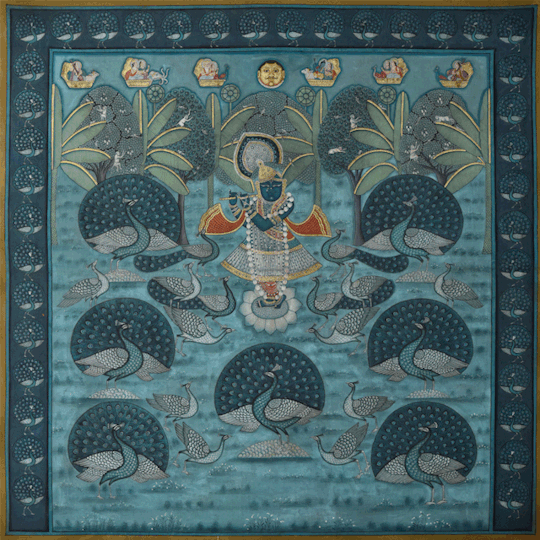
Origins and Significance:
Pichwai, derived from the words 'pich,' meaning back, and 'wai,' meaning hanging, literally translates to 'something that hangs behind.' These paintings traditionally adorned the walls behind the main deity in the temples of Nathdwara, particularly in the renowned Shrinathji Temple. Shrinathji, a form of Lord Krishna, is the central figure in Pichwai paintings, and each artwork narrates tales from the life of Krishna, especially his exploits as a child.
Devotion on Canvas:
Pichwai paintings are not merely artistic expressions; they are acts of devotion. The artists, often belonging to the Pushti Marg sect, express their deep reverence and love for Lord Krishna through these intricate artworks. The process involves a meticulous blend of spirituality and creativity, with each stroke of the brush echoing the artist's devotion and commitment to the divine.
Intricate Techniques:
The creation of a Pichwai painting is a laborious process that demands exceptional skill and patience. The artists, known as Pichwai painters, employ traditional techniques passed down through generations. These include intricate brushwork, the use of natural pigments, and detailing that captures the essence of the stories being depicted. The choice of colors is symbolic, with each hue carrying a specific meaning and contributing to the overall narrative.
Seasonal Variations:
One fascinating aspect of Pichwai paintings is the way they change with the seasons. The art reflects the festivals and seasons associated with the life of Krishna. For instance, during the festival of Holi, Pichwai paintings may depict scenes of Krishna playing with colors, while during the monsoon, they might showcase Krishna dancing with peacocks. This dynamic aspect not only adds versatility to the art but also connects it deeply with the cultural and religious calendar of the region.
Preservation of Tradition:
In an era marked by rapid modernization, Pichwai paintings serve as guardians of a rich cultural heritage. The artists, often belonging to families with a long-standing tradition of Pichwai painting, play a crucial role in preserving and passing on this art form to the next generation. Each stroke on the canvas is a link to the past, a bridge that connects the contemporary world with the centuries-old traditions of Nathdwara.
Beyond Temples:
While Pichwai paintings originated as temple art, they have transcended their religious context to become coveted pieces of art for collectors and enthusiasts worldwide. The beauty and spiritual essence of Pichwai have found their way into galleries and homes, making them not just religious artifacts but also expressions of artistic brilliance.
Conclusion:
The stories behind Pichwai are as diverse and colorful as the paintings themselves. From the devotion-infused strokes of the artists to the seasonal nuances that breathe life into the canvas, Pichwai art is a testament to the rich tapestry of Indian culture. It stands as a bridge between the divine and the earthly, inviting us to immerse ourselves in the stories that have been lovingly painted through generations, encapsulating the timeless tales of Lord Krishna.
Discover the enchanting world of Pichwai paintings at www.beyondsquare.in, where tradition meets modern convenience. Immerse yourself in the intricate artistry and vibrant colors of these traditional Indian artworks. With a seamless online buying experience, Beyond Square brings the timeless beauty of Pichwai paintings to your doorstep, making cultural indulgence just a click away.



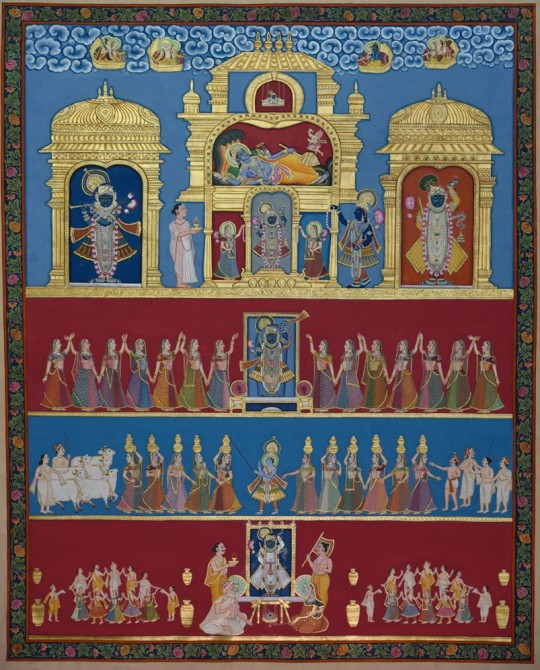
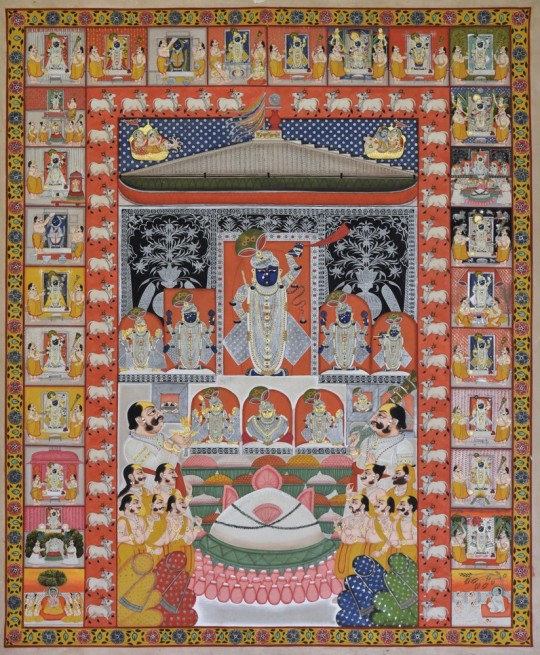


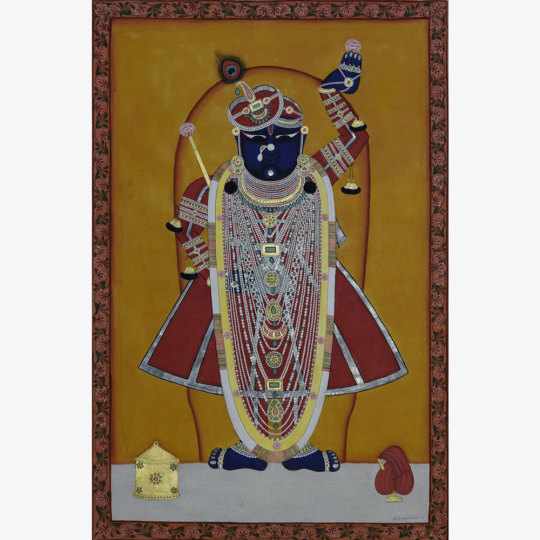
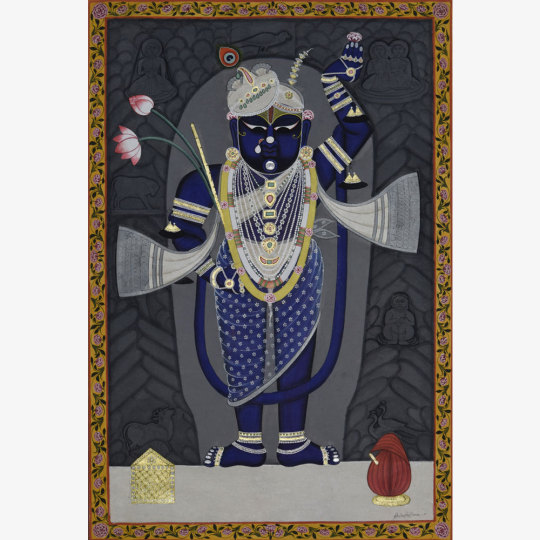



#pichwai paintings#krishna paintings#traditional indian art#traditional art#krishna leela paintings#rajasthani paintings#traditional drawing#traditional painting
1 note
·
View note